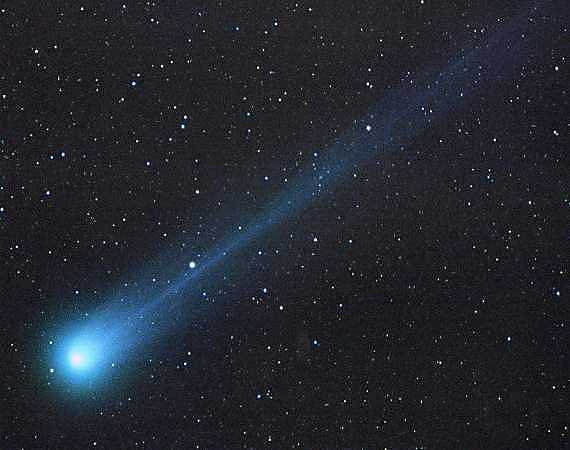| The Planet Quiz Show |
|---|
| The Planet Quiz Show |
|---|
For Teachers:
Comets are essentially dirty snowballs from one to 50 miles in diameter. They are composed of varying ratios of ices (mostly water) and dust. Their tails are created when a cometís orbital path brings it close to the sun. Solar energy first boils (sublimates) the ices, and then (ultraviolet energy) causes these gases to glow. Jets of escaping gas take with them small particles of dust that reflect (actually scatter) light back towards Earth. These two processes allow a comet to be seen.
![[Comet Holmes composite wide field]](51a.jpg) |
|---|
| Like a bolt out of the blue, a faint comet visible only in the largest of telescopes suddenly brightened by over 600,000 times to become visible to the unaided eye. The event unfolded on October 24, 2007 as Comet 17P/Holmes literally seemed to explode from nothingness to one of the brightest comets of the last decade. This image shows the progression of Comet Holmes over a 13 day period near the bright star Mirfak in the constellation Perseus the Hero. Composite photography by Gary A. Becker... |
![[Comet Holmes compared]](51b.jpg) |
|---|
| Going, going, but not quite goneÖ Compare how Comet Holmes increased in size and decreased in brightness in these two identically scaled images. Holmes was as huge as the sun in the November 10, 2007 image and eight times the sunís volume in the November 27 photo. Images by Gary A. Becker... |
 |
| Comet Hyakutake had a beautiful blue gas tail when it passed only 9.6 million miles from Earth during the Spring of 1996. This picture of Comet Hyakutake shows what the comet looked like from just outside the Lehigh Valley on the cold, windy evening of March 23, 1996. By March 27th the comet's tail stretched more than halfway across the heavens from dark sky locations in the Southwestern US. Gary A. Becker photo... |